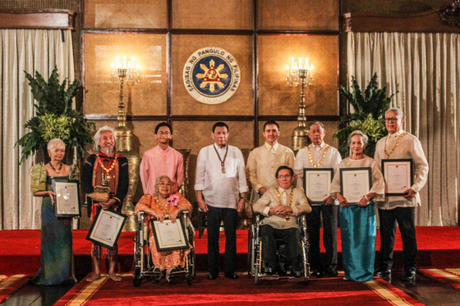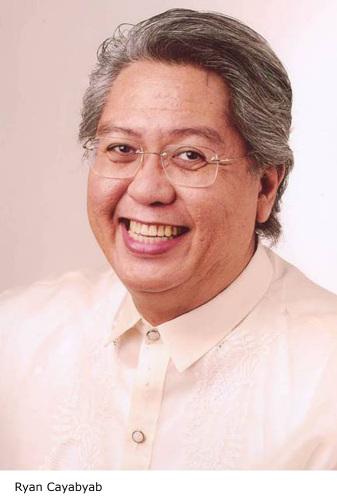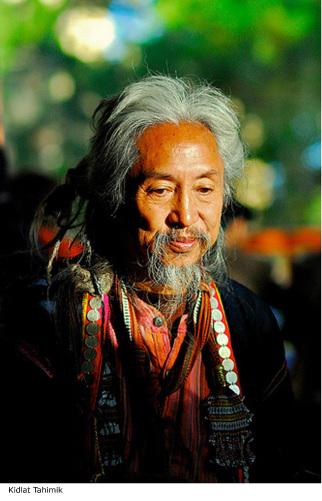
PRESIDENT Rodrigo Duterte has conferred the National Artist Awards to seven exemplar individuals for their significant contributions to the development of Philippine arts and culture on October 24, 2018, at the Rizal Ceremonial Hall of Malacañang Palace.
Upon recommendation by the Cultural Center of the Philippines (CCP) and the National Commission for Culture and the Arts (NCCA), after the rigid evaluation and selection process conducted by panels of artists, cultural workers, scholars and experts, visual artist Lauro "Larry" Alcala, theater advocate Amelia Lapeña Bonifacio, music master Raymund "Ryan" Cayabyab, filmmaker Kidlat Tahimik, architect Francisco Mañosa, literary writers Resil Mojares and Ramon L. Muzones were declared National Artists, joining the league of Filipino artists who have received the highest recognition bestowed by the nation.

"The cartoon is meant to entertain, record events and capture local color. It is also a self-correcting medium because it can humorously expose society's ills and serve as a mirror in which people can see themselves. It can also project the best in a people and a country," Alcala once remarked. His wife Guadalupe received the posthumous award.
Lapeña-Bonifacio established the Teatrong Mulat ng Pilipinas, which helped place the Philippines on the world theater map. She wrote plays based on materials culled from painstaking researches, and had been involved in the production and design of puppets. She was instrumental in the surge of children's theater in the Philippines, through the magic of puppetry.
Drawing upon the untapped wealth of Philippine and Asian folklore and experimenting with various forms and techniques of Asian theater arts and puppetry, she enriched the Philippine cultural heritage in drama. She successfully synthesized a myriad of rich puppet traditions from Southeast Asia, earning for herself the title "Grand Dame of Southeast Asian Children's Theatre."
Cayabyab's diverse compositions, which exhibit both mastery of composition technique and spontaneity, has made a great impact in the Philippine music industry. His music reflects the exuberance of life and human happiness, thus capturing the very essence of our Filipino soul. It embodies the Filipino values and social experiences. His learned, skillful, and versatile musical style spans a wide range of genres: from conservatory or art compositions such as concert religious music, symphonic work, art song, opera, and concerto to mainstream popular idioms in the music industry and in live contemporary multimedia shows (musical theater, dance, and film).
Mr. C, as he is fondly called, is distinctively a cosmopolitan nationalist. He is open to foreign influences but transforms these into expressions that are near to his experience as an urbanized Filipino. All throughout his career, Cayabyab never effaced his Filipino identity as he confronted the constant threat of making the Philippines a market for global expressions.

His debut film, Mababangong Bangungot (1977), was praised by critics and filmmakers from Europe, North America, Asia, and Africa and is still considered by many as a pioneering postcolonial essay film. Kidlat's "imperfect" film is an exemplar of what is worldwide known as "Third Cinema," a cinema that is critical of neocolonial exploitation and state oppression. But, unlike other Third Cinema films, Kidlat's work does not glory in ugliness. His films, even those that lament injustice and violence, are premised on the hope of possible, though yet unrealized, triumph. His constant claim is that whatever "progress" has relegated to the realm of sadness and poverty should never remain self-referentially sad or poor.
In his more than 60 years of architecture life, Mañosa designed Filipino. From the 1960s until his retirement in 2015, he courageously and passionately created original Filipino forms, spaces with intricate and refined details. Through the years, he successfully and even playfully constructed these forms and spaces into masterpieces for both the poor and the rich. Mañosa knew that real creative growth happens when his architecture is isomorphic to the true nature of Filipino clients, in his Philippines.
At the heart and soul of a Philippine architectural movement, he intensively studied, mastered and interpreted many Filipino visual imageries. He passionately and painstakingly developed the use of indigenous materials, bamboo, coconut, rattan, capiz, and various kinds of inlay and applied all these into first class architectural finishes, furniture and furnishings.
Mañosa championed that Philippine architecture must be "true to itself, its land and its people" with such directness and conviction. Undaunted, Mañosa coined "Filipinism" as his style. This is quite evident in the buildings he designed, including the Tahanang Pilipino (or the Coconut Palace) where he invented numerous coconut product finishes, internationally awarded Aman Pulo Resort with its deconstructed "bahay kubos" style, and the San Miguel Building with its rice terrace-like green balconies and "tukod" inwardly slanting windows, a perfect example of sustainable architecture.
An educator, scholar, essayist and fictionist, and cultural/literary historian, Mojares is one of the leading figures in regional literature and history. As founding director of the Cebuano Studies Center, an important research institution which placed Cebu in the research and documentation map, he pioneered Cebuano and national identity formation. As a leading figure in cultural and literary history, he networked actively in many organizations.
For over 50 years, Mojares has published in diverse literary forms (fiction, essay, journalism, scholarly articles, and books) across a wide range of discipline (literature, history, biography, cultural studies, and others). To date, he has 17 published books (3 more in the press) and edited, co-edited, or co-authored 11 books, and written numerous articles for popular and scholarly publications.
Muzones was a Hiligaynon poet, essayist, short story writer, critic, grammarian, editor, lexicographer, and novelist who authored an unprecedented 61 completed novels. Some of his works represent groundbreaking "firsts' in Hiligaynon literature such as the feminist Ang Bag-ong Maria Clara, the roman a clef Maambong Nga Sapat (Magnificent Brute,1940), the comic Si Tamblot (1946), the politically satirical Si Tamblot Kandidato Man (Tamblot is Also a Candidate, 1949), the 125-installment longest serialized novel Dama de Noche (1982-84), etc.
Hailed by his peers as the longest reigning (1938-1972) among "the three kings of the Hiligaynon novel," Muzones brought about its most radical changes while ushering in modernism. With a literary career that spanned fifty-three years (1938-1990), his evolution covers the whole history of the Hiligaynon novel from its rise in the 1940s to its decline in the 1970s. Muzones tried his hand at a variety of types and proved adept in all as literary fashions. In the process, he not only extended with remarkable versatility and inventiveness the scope and style of the Hiligaynon novel, he enriched Hiligaynon literature's dramatis personae.
In his prepared speech, Duterte urged the newly-proclaimed National Artists to never hesitate to pass down their knowledge and skills to the younger generations "because it is only by educating and training the youth that the legacy and work of our artists can live on."
"To this year's awardees, I laud you for the passion and dedication to your chosen craft. Your outstanding work does not only inspire self-determination, but likewise instills patriotism and brings prestige to our beloved country. As we celebrate Filipino excellence in all forms, may your creativity and artistry continue to inspire our people to become positive in building a more progressive and vibrant Philippines," said the President.
Duterte recognized the role of arts in the development of the Filipino society. "In ways more than one, art has been a witness to this storied history of our nation. It gave rise to the revolutions and served as a voice to those who fought for democracy and emboldened the spirit of the Filipino during the turbulent times. Indeed, art has gone as a general service and we recognize this by supporting our local and traditional artist and spearheading initiatives to safeguard, preserve, and protect our cultural sites."
The selection for the new National Artists, jointly administer by the CCP and NCCA, began after the call for nominations on June 2017. A council of experts conducted the initial deliberation and shortlisted the nominees. The second deliberation by a Jury of experts further evaluated the nominees and their body of works.
After which, the Jury submitted their recommendations to the boards of the CCP and the NCCA. Joined by current and living National Artists, the boards voted on the final nominees, which they recommended to the President. The Office of the President's Honors Committee reviewed the final list before transmitting to the President, who has the prerogative to affirm all or just some of the recommended names, but he is not allowed to add to what has been submitted by the NCCA and the CCP.
National Artist Virgilio Almario, who is also the NCCA chairman, congratulated the new National Artists and believed that the diversity and excellence of this year's awardees is a reflection of the Filipino imagination.
"Bagama't iba't-iba ang larangan, lahat ito ay konektado, sumasalamin at kumakatawan sa kung ano ang pinakamainam at pinakamagaling sa Filipino at sa kulturang Filipino. Hindi lamang simpleng pagkilala ito kundi ito ay isa ring paglulok sa mga sagisag ng ating bansa na may mahabang kasaysayan ng haraya, pagkamalikhain at kagalingan para sa lahat," he enthused.
###
Press Release from CCP PR
